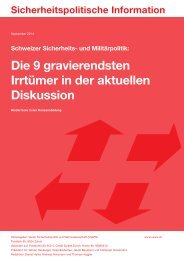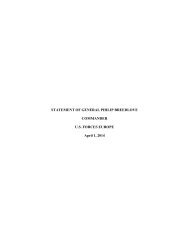FULLTEXT01
FULLTEXT01
FULLTEXT01
You also want an ePaper? Increase the reach of your titles
YUMPU automatically turns print PDFs into web optimized ePapers that Google loves.
TACTICAL THOUGHT<br />
2014 September 29 th<br />
The whole area of tactics in Irregular Warfare is mainly thought of to have a low<br />
priority in the Swedish Armed Forces, however, a rather common view does exist that<br />
development of such tactics is needed and important.<br />
Conceptual and Contextual thinking perspectives – A Discussion of the<br />
result<br />
The overall result of the open questions reveal battalion and company commanding<br />
officers’ collective and diversified articulations of tactics in general, as well as on<br />
tactics in Irregular Warfare. Two main views exist on tactics per se, either as a label for<br />
the practical use of units for a specific goal, or as a label for methods to solve military<br />
problems, giving different approaches to discussing tactics. In combination with the<br />
dominant Regular Warfare influence, as a more generic and wider analytical approach,<br />
or a more direct Irregular Warfare tactics perspective, different approaches might evolve<br />
when discussing and communicating the subject. Opinions on primary influences on<br />
tactical thinking concerned several different areas, which is why the possible discourse<br />
is growing.<br />
A unifying view can nonetheless be noticed regarding the stated importance of practical<br />
experiences and exercises. However, if opportunities for practice of command decline,<br />
different views might evolve around other unifying aspects. A clear interest even so, is a<br />
common message regarding tactics compared to that of strategy and operational art. If<br />
however this is not communicated to any substantial part as indicated, tactical thinking<br />
development risks degradation. Views on how important development influences tactics<br />
and thinking, relating to experiences and influences from past wars, support an opinion<br />
of the importance of real life practice, also in a larger context. The few opinions on<br />
influences for development of tactics and tactical thinking regarding education support<br />
the above opinion. In summary, different opinions exist concerning understanding of the<br />
subject of tactics per se, doubtless with a main influence from the long tradition of<br />
Regular Warfare tactics. Turning to the more demarcated area of tactics in Irregular<br />
Warfare, it is mainly seen as a lower prioritized area of tactics. General expressions<br />
concern conceptual aspects including capability and functional area aspects, for<br />
example, intelligence. This indicates a traditional Regular Warfare mind-set, mentioned<br />
above. The more limited highlighting of broader aspects, such as military and civilian<br />
relations, education and training, leadership and mind-set, supports this view.<br />
However, indications are also clear about the existence of several, if not coherent, views<br />
that correspond to current COIN thinking. One such example is the emphasis on<br />
thinking related to new or other demands in command and function areas, such as<br />
Intelligence, Psychological Operation (PSYOPS) and Electronic Warfare (EW). As for<br />
thinking about conceptual solutions, contextual thinking intermingles and it is not<br />
possible to demarcate strictly. An apparent focus on moral aspects in Irregular Warfare<br />
contexts puts several demands on unit concepts with capabilities other than in Regular<br />
Warfare. One such example is intelligence analysis, aiming for targeting precision and<br />
hidden enemy identifications.<br />
63





